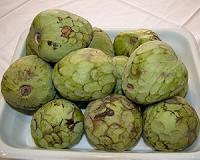 |
Madison, Wis. (UPI) Mar 15, 2011 A U.S. Department of Agriculture researcher says he has rediscovered a forage grass well suited to contemporary intensive rotational livestock grazing. A farmer's report of an unusual forage grass on his dairy farm near Mineral Point, Wis., led Agricultural Research Service geneticist Michael Casler in Madison to identify the grass as meadow fescue, an ARS release reported Tuesday. Meadow fescue had been long forgotten as a forage grass, although it was popular after being introduced about 50 to 60 years before the introduction of the more common tall fescue, researchers say. Using the discovery Casler has developed a new variety of meadow fescue he's dubbed Hidden Valley and is growing seeds for future release. Meadow fescue has non-toxic fungi called endophytes living inside it, helping it survive heat, drought and pests. Unlike the toxic endophytes inside many commercial forage grasses, like tall fescue and ryegrass, meadow fescue does not poison livestock, the ARS said. Casler and his colleagues have since found the plant, which is very winter-hardy and persistent, on more than 300 farms in Wisconsin, Iowa and Minnesota. Geoffrey Brink, an ARS agronomist working with Casler, said meadow fescue is 4 percent to 7 percent more digestible for livestock than other cool-season grasses dominant in the United States.
Share This Article With Planet Earth
Related Links Farming Today - Suppliers and Technology
 Seedless Cherimoya, The Next Banana
Seedless Cherimoya, The Next BananaDavis CA (SPX) Mar 15, 2011 Mark Twain called it "the most delicious fruit known to man." But the cherimoya, or custard apple, and its close relations the sugar apple and soursop, also have lots of big, awkward seeds. Now new research by plant scientists in the United States and Spain could show how to make this and other fruits seedless. Going seedless could be a big step for the fruit, said Charles Gasser, professo ... read more |
|
| The content herein, unless otherwise known to be public domain, are Copyright 1995-2010 - SpaceDaily. AFP and UPI Wire Stories are copyright Agence France-Presse and United Press International. ESA Portal Reports are copyright European Space Agency. All NASA sourced material is public domain. Additional copyrights may apply in whole or part to other bona fide parties. Advertising does not imply endorsement,agreement or approval of any opinions, statements or information provided by SpaceDaily on any Web page published or hosted by SpaceDaily. Privacy Statement |